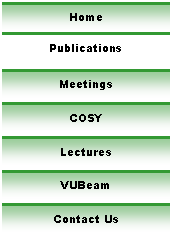
|
Reprint Server |



The Influence of Fringe Fields on Particle Dynamics in the Large Hadron Collider
Abstract
The need of maximizing luminosity in the Large Hadron Collider requires the use of High-Gradient Quadrupoles in the interaction region. These quadrupoles combine relatively short length, large aperture, and short focal length with a rather peculiar configuration of the return coils, all of which enhances the relevance of their fringe field effects. The influence of resulting nonlinearities on the dynamics is analyzed via high-order maps determined with Differential Algebraic (DA) techniques and the code COSY INFINITY. Normal form methods are utilized to determine amplitude dependent tune shifts as well as resonance strengths. An analysis based on a detailed description of the fringe field of the superconducting quadrupoles reveals that the strength of resonances increases by more than one order of magnitude , and that amplitude-dependent tune shifts are enhanced substantially.W. Wan, C. Johnstone, J. Holt, M. Berz, K. Makino, M. Lindemann, B. Erdelyi, Nuclear Instruments and Methods A427, 74-78 (1999)
Download
Click on the icon to download the corresponding file.
![]() Download Postscript version (823828 Bytes).
Download Postscript version (823828 Bytes).
![]() Download Adobe PDF version (128160 Bytes).
Download Adobe PDF version (128160 Bytes).
Go Back to the reprint server.
Go Back to the home page.
This page is maintained by Kyoko Makino. Please contact her if there are any problems with it.